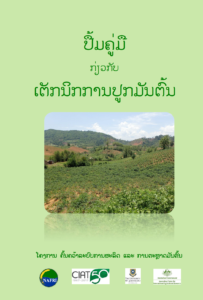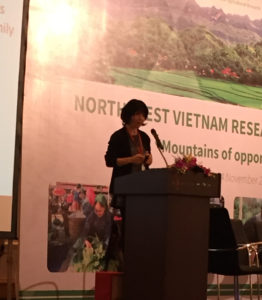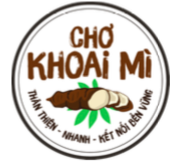Effect of Potassium on the Growth and Yield of Cassava
LaoThao Youbee - Masters Thesis February 2019 (Lao and English)
Cassava (Manihot esculenta Crantz), a perennial shrub grown in tropical and sub-tropical region of Africa, Asia and Latin America. Root crop cassava has a reputation of degrading the soil. The objectives of this study were to determine the effect of Potassium (K) rate on the growth and yield of cassava and it’s economic benefit. The study was conducted at Maize and Cash Crops Research Center, National Agriculture and Forestry Institute (NAFRI). The soil texture of the experimental site was sandy loam and presence of K was on an average 0.16 me/100g. Cassava variety Rayong 11 was hand planted in March, 2018 and harvested in November 2018. The experiment was conducted in randomized complete block design (RCBD) with three replications and 5 treatments. The treatments were 4 rates of potassium 0, 40, 80 and 120 Kg/ha as K2O along with N:P2O5 (40:20 Kg/ha) and a control (without fertilizer). The experimental unit size was 30 m2 and the density of cassava were 10,000 plants/ha. Plant height, root yield and starch content was measured. After 180 days growth plant height was significantly different (p <0.05) between the treatments. Cassava plant height was lowest for control treatment (i.e. 168.9 cm) and highest (i.e. 196.6 cm) was for treatment with highest K (i.e. 120kg/ha). Cassava root yield were significantly different (p<0.01) among the treatment and increased with increasing K rates. The treatment with high K (i.e.120 kg/ha) yielded 37.60 t/ha whereas control treatment (i.e. without fertilizer) was 21.57 t/ha. Relationship between the application of K rates and cassava root yield was highly correlated (R2=0.739). Economics analysis showed that application of K increased profitability. The profit per hectare was between 3,661,500 and 9,599,000 kip while market price of fresh root was 550,000 kip/t in November, 2018. This study showed that application of K enhanced profit ranging between 1.63 to 2.62-fold. The least profitable treatment was without any fertilizer application and the highest profit-making treatment was at high K treatment.
Agrarian transition, gender and social differentiation:
Smallholders’ responses to a boom commodity cassava in Vietnam
Nozomi Kawarazuka
In Southeast Asia, the areas of export-orientated boom cash commodities have been expanding. The literature on political ecology has questioned its sustainability and there is a growing concern about the implications for social equity and social justice. Drawing upon the feminist political ecology built on the critical social theory of gender (Elmhirst, 2011b), this study has explored the diverse responses and impacts of a cassava boom in four study communities in Vietnam. The study has shown that there is no single victim narrative of land grabs and debt. Instead, the processes of incorporation into boom crops are diverse and dynamic. Those varieties can be explained by not only their settlement history and socio-economic conditions but also by the gender and social norms, which impede or facilitate access to the resources of specific social groups. Social relations among value-chain actors are deeply embedded in local social and cultural norms, which resulted in ethnic minorities being disconnected from the powerful value-chain actors who hold information. The study concludes with implications for agricultural interventions for more sustainable farming systems; without considering the different needs and interests of diverse social groups, interventions run the risk of supporting the wealthy large-scale cassava farmers, who can afford agricultural inputs, labour and time, while further marginalising the poorest of the poor who also depend heavily on cassava with limited financial resources and male family labour.
This business case describes a blueprint to build a successful
business model that will strengthen linkages in the cassava value-
chain in Dak Lak, Vietnam. Once such a blueprint is well-
constructed, it can be used to replicate similar business models in
other provinces of Vietnam, neighbouring countries such as
Indonesia and Cambodia, and potentially other agriculture
products. The end goal is to improve the livelihood of different actors in the value chain: farmers, traders, cassava processing companies, etc.
The starting idea is to utilise a smartphone app that allows different actors in the value chain to post buying/selling prices and quantity of cassava. There are, however, many factors that would contribute to whether the app can succeed in the marketplace.
Social dimensions of a cassava production and value-chain: Why do the poor continue with unsustainable cassava production?
CIAT Blog
Cassava was once a major boom commodity in rural areas in Vietnam, produced on an industrial scale to meet a growing global demand for starch, animal feed, and biofuel. However, the sustainability and livelihoods of smallholder farmers continues to be challenged by soil erosion and declining fertility leading to low productivity. In the past two years, this has been exacerbated by unstable and falling prices. The responses to these challenges differ significantly between the better-off and the poor: the better-off have shifted to producing other commodities such as coffee, cashews and pepper, while the poor continue to grow cassava with little profit or sell/rent their land to wealthy outsider investors and work for them as laborers.
Clearly the long-term consequences for the poor of a ‘backwash’ after the cassava boom are severe, which raises the questions of why they continue with unsustainable and increasingly economically marginal cassava production, and what are poor farmers’ values and beliefs in farming? In order to identify appropriate support for them, it is essential to find answers and understand the social as well as the economic reasons behind their choices.


